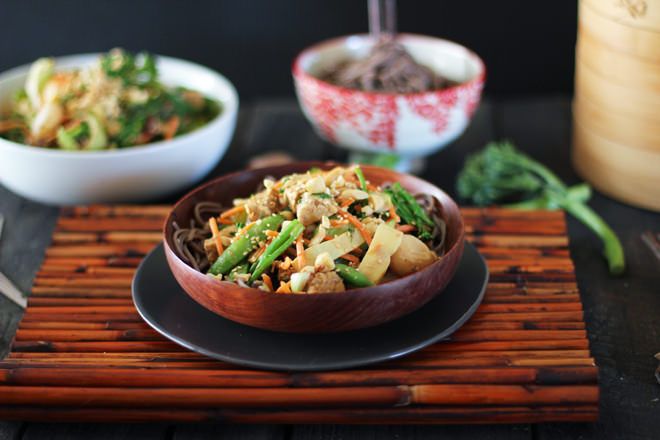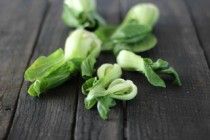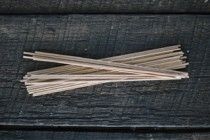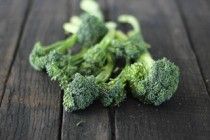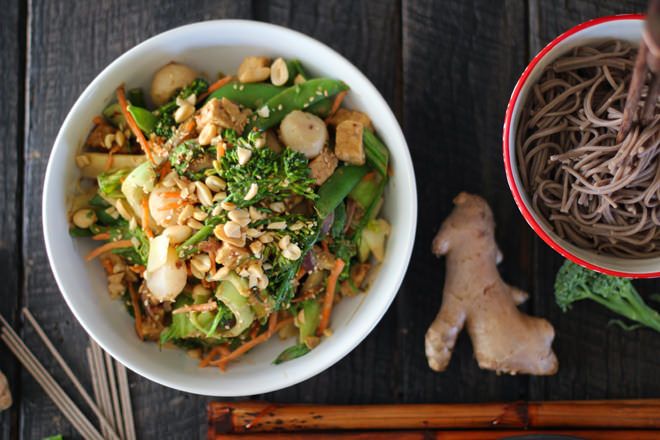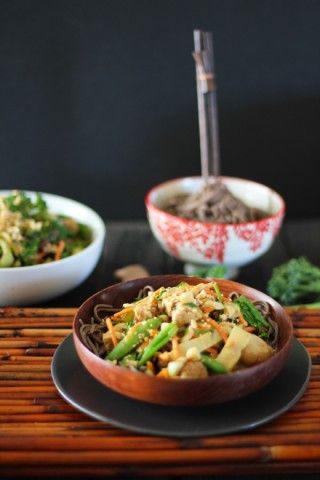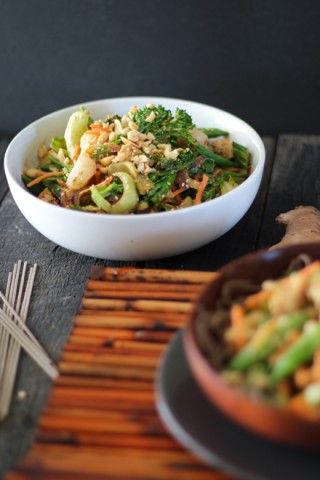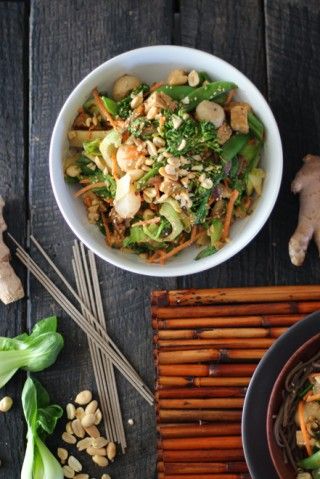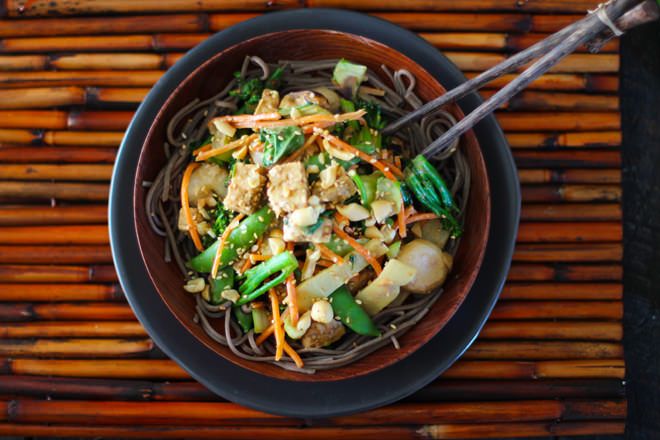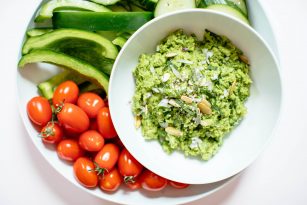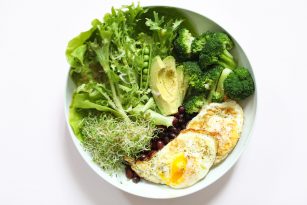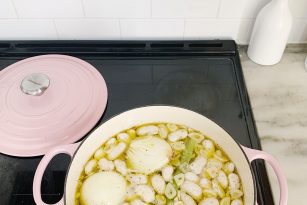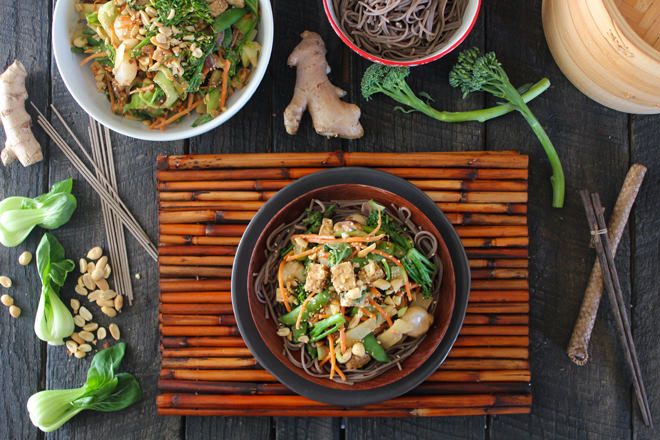 There’s a local thai restaurant here in Nashville that serves pad thai dish that I love; I was inspired by that delicious dish to recreate my own vegetarian and gluten free friendly version. Peanut Tempeh Stir-Fry with Soba Noodles is filled with sweet, spicy, and salty flavors with chewy and crunchy bits. It’s great to make ahead of time in large batches for leftovers but also quick enough to make for dinner- it’s deliciously simple.
There’s a local thai restaurant here in Nashville that serves pad thai dish that I love; I was inspired by that delicious dish to recreate my own vegetarian and gluten free friendly version. Peanut Tempeh Stir-Fry with Soba Noodles is filled with sweet, spicy, and salty flavors with chewy and crunchy bits. It’s great to make ahead of time in large batches for leftovers but also quick enough to make for dinner- it’s deliciously simple.
This dish contains heaps of fibrous veggies, protein rich tempeh, healthy fats, and manganese rich soba noodles. Stir-frys are another one of my go-to dinners especially towards the end of the week when usually I’m running low on produce and groceries. I’ll simply use frozen veggies I have on hand like carrots, peas, red bell peppers, corn and broccoli, heat up the skillet with sesame oil, garlic and onions, and whip up a stir-fry on the fly (ha).
I suppose what I do, isn’t technically stir-frying as 1) I don’t use a traditional wok, 2) I don’t use as high of heat, and, 3) I don’t have awesome chef skills to flip all of the goodies around in the pot without them spilling over (I’m working on that one). What my stir-fry does have in common with traditional stir-frys, is the blend of fresh vegetables, protein, and aromatics cooked quickly leaving them crunchy and serving with noodles or rice.
What are soba noodles? Soba noodles are thin noodles made from the buckwheat and used in most Japanese cuisines; hence the name soba, which actually means buckwheat in Japanese. They’re used in hot dishes like soups and stir-frys or cold noodle dishes with dipping sauces, of course the list is very long of how soba noodles are used in Japanese cuisine. I love using these noodles in any/all dishes for their versatility, texture, and taste. How is a word with “wheat” in it, gluten free? As I mentioned, soba noodles are made from buckwheat, which is a type of “grain”. You may be thinking buckwheat contains wheat right? Although buckwheat has the word “wheat” in the name- it’s actually gluten free! Buckwheat technically is a seed (a triangular shaped seed), but is used like a grain or wheat such as with flours. Much more on the wonders of buckwheat for a later post!
Fun fact // most gluten free beers now use buckwheat as the grain to be fermented compared to barely or hops which are gluten containing.
TIP // you can purchase gluten free soba noodles at most grocery stores, asian markets, and health food stores. If you’re gluten free, be sure the package says “gluten free”. Some soba noodles also have mix of wheat flour in them.
Tempeh is a great plant-based protein filled with healthy fats and fiber as well. I’ve used it in several recipes to create a hearty and satisfying main dish, vegetarian style. If you’ve never used tempeh before, I urge you to try it at least once and this is a great recipe to start with. If you’re wondering what the health benefits of tempeh are check back to this post too.
Nutrition breakdown // In 4 ounces (a typical serving) of tempeh, there is a whopping 20g of protein, 11g of fiber, and 9g of healthy fats. The nutrition information will differ between brands, but in general this will be a similar breakdown of macronutrients.
Serve |
- Top with fresh diced green onions or scallions
- Serve with soba noodles on the side or mix into the stir-fry
- Gently roast peanuts or cashews in the hot skillet after you’ve cooked the stir-fry (to get all of the good “bits”), chop, and sprinkle on top of the finished stir-fry
- If you don’t have soba noodles on hand use wild rice, quinoa, or jasmine rice for another carbohydrate alternative
- Watching your carbohydrate intake? Simply use half of the amount of noodles and bump up the veggies and proteins in this dish to keep you full
- Sprinkle red pepper flakes or sriracha on top for a kick of heat!
- 1 package/8oz. soba noodles (100% buckwheat, Eden Foods)
- 1 package/8 oz. of organic tempeh
- 3 cups (200g) brocollini, chopped
- 3 cups (180-200g) bok choy, chopped
- 1 cup carrots, sliced/shredded
- 1 cup sugar snap peas
- 1/2 cup water (for sauce)
- 1/2 cup celery, chopped
- 1/4 cup red onion, chopped
- 1/4 cup water chestnuts
- 1/4 cup bamboo shoots
- 1/4 cup organic peanut butter
- 3 tablespoons low sodium organic Tamari (gluten free soy sauce)
- 1 tablespoon grated fresh ginger
- 1 tablespoon sesame seeds (to garnish)
- 1-2 tablespoons organic sesame oil
- 1 tablespoon chopped peanuts or cashews (to garnish)
- 2 teaspoons red chili flake
- 2 cloves garlic, diced
- sea salt to taste (adjust as needed)
- In a large pot, boil water to cover soba noodles (about 5 cups of water). Cook until soft while you’re cooking the stir-fry.
- TIP when cooking gluten free noodles, cook for about 8 minutes and run under cold water after cooking- this helps prevent them sticking together.
- In a large skillet, combine sesame oil with garlic, onions, celery, and carrots.
- Cook for 5 minutes or until onions are clear.
- Cut the tempeh into cubes, add into the large skillet and cook for 5 minutes.
- Add remaining vegetables into the large skillet and cook until vegetables are al dente.
- In a small mixing bowl, combine peanut butter, tamari, water, and ginger into a paste.
- Once the vegetables are at a texture you enjoy (I prefer al dente), add in the peanut butter, ginger, and tamari until well combined. The end result will be a thick and creamy coating over the entire stir-fry.
- Take off the heat.
- In the separate pot, once the soba noodles have completely cooked add the noodles into the large skillet and stir to combine. You may need to add a little of the soba noodle water (that you’ve cooked the noodles in) to the large skillet to thin out the sauce to your desired consistency. Add in a tablespoon at a time.
- Garnish with peanuts and sesame seeds.
- Enjoy!
Be sure to “SAVE” this recipe in your Recipe Box for later! I hope it’ll become one of your recipe staples on batch cooking day just like it is mine. Also, keep in mind that this recipe is very versatile, if you don’t have an ingredient or don’t like an ingredient in the recipe simply use what you have on hand!
Enjoy!
xo McKel



